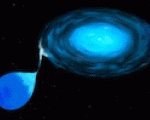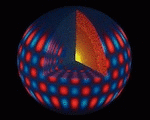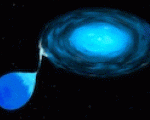- Academics
-
Research
- Observatories
- Extragalactic Studies at UVA
- Planetary Science
- Virginia Institute of Theoretical Astronomy
- X-ray Astronomy and Clusters of Galaxies Group
- Near-Field Cosmology
- Exploding Stars and Time Domain Astronomy
- Galaxy Evolution and Cosmology Initiative (GECO)
- Virginia Initiatives on Cosmic Origins
- Outreach
- People
Graduate Courses
Currently Offered Classes:

ASTR 5010: Astrophysical Processes (3 credits)
Prerequisite: ASTR 2110, 2120 (recommended); MATH 5210, 5220; PHYS 3210, 3310 (concurrent), 3430 (concurrent), 3650; or instructor permission.
Basic concepts in mechanics, statistical physics, atomic and nuclear structure, and radiative transfer are developed and applied to selected fundamental problems in the areas of stellar structure, stellar atmospheres, the interstellar medium and extragalactic astrophysics.

ASTR 5110: Astronomical Techniques (4 credits)
Prerequisites: ASTR 2110-2120; PHYS 342, 343 or permission of instructor.
This course surveys modern techniques of radiation measurement and data analysis and their application to astrophysical problems, especially the physical properties of stars. Relevant experiments in the laboratory and at the telescope will be included.

ASTR 5260: Introduction to Astrochemistry (3 credits)
Prerequisite: Permission of instructor
This interdisciplinary course will introduce graduates and advanced undergraduates to molecules and their chemistry in different sources throughout the universe. Major topics include chemistry in interstellar clouds and star-forming regions, the kinetics of gas-phase and grain-surface reactions, astronomical spectroscopy, laboratory experiments, and astrochemical modeling. The class will cater to students with either an astronomy or chemistry background, to provide the knowledge and tools needed to understand the main themes and problems in astrochemistry. The course will also provide a foundation to those moving into astrochemistry research.

ASTR 5340: Introductory Radio Astronomy (3 credits)
Prerequisites: MATH 235, PHYS 210.
Fundamentals of measuring power and power spectra, antennas, interferometers, and radiometers. Thermal radiation, synchrotron radiation and line frequency radiation. Radio emission from the planets, sun, flare stars, pulsars, supernovae, interstellar gas, galaxies and quasi-stellar sources.

ASTR 5420: The Interstellar Medium (3 credits)
Prerequisite: Permission of instructor.
Topics covered include the physics of interstellar gas and grains, the distribution and dynamics of the gas, and cosmic radiation and interstellar magnetic fields.

ASTR 5430: Stellar Astrophysics (3 credits)
Prerequisite: Permission of instructor.
Observed properties and physics of stars. Radiation transfer; stellar thermodynamics; convection. Formation of spectra in atmospheres. Equations of stellar structure; nuclear reactions. Stellar evolution and nucleosynthesis. Applicable numerical techniques.

ASTR 5450: High Energy Astrophysics (3 credits)
Prerequisite: Permission of instructor.
Introduction to the physics of basic radiation mechanisms and particle acceleration processes which are important in high energy phenomena and space science. Applications to pulsars, active galactic nuclei, radio galaxies, quasars, and supernovae will be discussed.

ASTR 5630: Extragalactic Astronomy (3 credits)
Prerequisite: Permission of instructor.
This course provides an overview of extragalactic astronomy. Topics include both qualitative and quantitative discussion of various types of galaxy (ellipticals, spirals, dwarf, starburst); results from theory of stellar dynamics; groups and clusters of galaxies; active galaxies; high-redshift galaxies; galaxy evolution; the intergalactic medium; and dark matter. The course is intended for advanced undergraduate astrophysics majors and first and second year graduate students. Prerequisite: Physics and Math through PHYS 2610, MATH 3250 (or equivalent); ASTR 2110, 2120 (or equivalent).
ASTR 5470: Computational Astrophysics (3 credits)
Prerequisite: Students must have completed MATH 3250 and (PHYS 2660 or PHYS 1655). Co-requisite: Students must have completed or be enrolled in MATH 4220.
Computational methods are widely applied in all areas of astrophysical research, including data analysis, instrumentation, and theory. This course covers advanced computing skills that optimize the scientific return from using increasingly complex code bases and sophisticated code development tools. Using Python, we introduce widely applicable numerical methods while training the students in the use of commonly used code development concepts.
ASTR 5460: Physics of Compact Stars (3 credits)
Prerequisite: Permission of instructor.
he compact stars - white dwarfs, neutron stars, and black holes - are the end state of stellar evolution. The conditions in and around these objects are extreme as compared to terrestrial standards, and they are responsible for some of the most powerful and dynamic phenomena in the universe. This course introduces the physics of strong gravity and dense matter required to understand compact stars and their observational manifestations.
ASTR 5480: Cosmology
This course covers topics associated with cosmology, the branch of astrophysics dealing with the origin and evolution of the Universe. The course begins with a historical overview and then focuses on three main areas: expansion of the universe, the early universe, and large-scale structure.
Note: Many students opt to take classes in other departments to supplement their background. Common departments include: Physics, Chemistry, Computer Science, and Engineering
Previously Offered Classes:

ASTR 5350: Radio Astronomy Instrumentation (3 credits)
Prerequisite: ASTR 5340 or permission of instructor.
An introduction to the instrumentation of radio astronomy. Discussion includes fundamentals of measuring radio signals, noise theory, basic radiometry, antennas, low noise electronics, coherent receivers, signal processing for continuum and spectral line studies, and arrays. Lecture material is supplemented by illustrative labs.

ASTR 5460: Binary Stars (3 credits)
Prerequisite: Permission of instructor.
The determination of orbital elements, the mass-luminosity-radius relation, formation of binary systems, the Roche model, mass loss, mass transfer, circumstellar material, accretion disks, evolution of close interacting binaries, and some special classes of binaries such as cataclysmic variables, RS CVn binaries, Algol-type binaries, and X-ray binaries.

ASTR 5480: Evolution of the Universe (3 credits)
Prerequisite: Permission of instructor.
The origin and evolution of structure in the universe. The formation and evolution of galaxies. Tests of the theory based on observations of large scale structure and the properties of galaxies as a function of lookback time.

ASTR 5610: Galactic Structure and Stellar Populations (3 credits)
Prerequisite: Permission of instructor.
This course explores the structure and evolution of star clusters and galaxies, with particular emphasis on objects in the local universe. Topics explored include the evolution of individual stars and their kinematics, chemistry, and spectral energy distributions, the effeE6CC99 such evolution on populations of stars with both simple and complex star formation histories, and galaxies as collections of stellar populations. The course introduces fundamental tools of Galactic astronomy, with topics including methods for assessing the size, shape, age, and dynamics of the Milky Way and other stellar systems, galaxy formation, interstellar gas and dust, dark matter, and the distance scale.